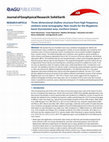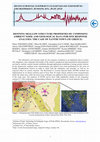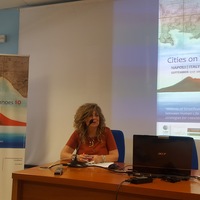Papers by Marios Anthymidis

We examine the use of ambient noise cross-correlation tomography for shallow site characterizatio... more We examine the use of ambient noise cross-correlation tomography for shallow site characterization using a modified two-step approach. Initially, we extract Rayleigh wave traveltimes from correlation traces of vertical component seismic recordings from a local network installed in Mygdonia basin, northern Greece. The obtained Rayleigh wave traveltimes show significant spatial variability, as well as distance and frequency dependence due to the 3-D structure of the area, dispersion, and anelastic attenuation effects. The traveltime data sets are inverted through a surface wave tomography approach to determine group velocity maps for each frequency. The proposed tomographic inversion involves the use of approximate Fresnel volumes and interfrequency smoothing constraints to stabilize the results. In the last step, we determine a final 3-D velocity model using a node-based Monte Carlo 1-D dispersion curve inversion. The reliability of the final 3-D velocity model is examined by spatial and depth resolution analysis, as well as by inversion for different model parameterizations. The obtained results are in very good agreement with previous findings from seismic and other geophysical methods. The new 3-D V S model provides additional structural constraints for the shallow sediments and bedrock structure of the northern Mygdonia basin up to the depth of ∼200-250 m. Present work results suggest that the migration of ambient tomography techniques from large scales (tens or hundreds of km) to local scales (few hundred meters) is possible but cannot be used as a black box technique for 3-D modeling and detailed geotechnical site characterization.

Journal of Geophysical Research: Solid Earth, 2014
ABSTRACT We examine the use of ambient noise cross-correlation tomography for shallow site charac... more ABSTRACT We examine the use of ambient noise cross-correlation tomography for shallow site characterization using a modified two-step approach. Initially, we extract Rayleigh wave traveltimes from correlation traces of vertical component seismic recordings from a local network installed in Mygdonia basin, Northern Greece. The obtained Rayleigh wave traveltimes show significant spatial variability, as well as distance and frequency dependence due to the 3D structure of the area, dispersion and anelastic attenuation effects. The traveltime datasets are inverted through a surface wave tomography approach to determine group velocity maps for each frequency. The proposed tomographic inversion involves the use of approximate Fresnel volumes and inter-frequency smoothing constraints to stabilize the results. In the last step, we determine a final 3D velocity model using a node-based Monte-Carlo 1D dispersion curve inversion. The reliability of the final 3D velocity model is examined by spatial and depth resolution analysis, as well as by inversion for different model parameterizations. The obtained results are in very good agreement with previous findings from seismic and other geophysical methods. The new 3D VS model provides additional structural constraints for the shallow sediments and bedrock structure of the northern Mygdonia basin up to the depth of ~200-250 m. Present work results suggest that the migration of ambient tomography techniques from large scales (tens or hundreds of km) to local scales (few hundred meters) is possible but cannot be used as a black box technique for 3D modeling and detailed geotechnical site characterization.

Bulletin of Earthquake Engineering, 2012
ABSTRACT A large number of earthquake studies using both empirical and theoretical approaches cle... more ABSTRACT A large number of earthquake studies using both empirical and theoretical approaches clearly depict the strong correlation of resulting damage and local geology. This correlation forms the scientific basis of the subsurface soil structure studies for site response evaluation, since adequate knowledge of the subsoil geotechnical and geophysical properties can lead to realistic seismic hazard estimation through appropriate modeling of strong seismic motion. In this framework, ambient noise analysis and one dimensional numerical simulation modeling have been performed for the town of Grevena (Northwestern Greece) in order to study both the subsurface soil structure, as well as its expected effect on seismic motions. The horizontal to vertical spectral ratio (HVSR) method was implemented on an almost uniform grid of 60 single station ambient noise measurements inside the urban area, while the noise array technique was applied at four selected sites of the study area. The HVSR curves show complex patterns, occasionally with double HVSR peak frequencies, with the higher one HVSR frequency showing a good correlation with the recent Holocene clay-dominant formation. Using these results, as well as information on surface geology and existing geotechnical data, a microzonation of the Grevena town is attempted, indicating zones of similar site response to ground motion. Numerical simulation of ambient noise with synthetic recordings suggests that the complex features observed in several HVSR curves could be attributed to the impedance contrast due to the quite shallow (Holocene clays to Pliocene–Pleistocene sands) and a deeper (Pliocene–Pleistocene sands to Oligocene–Miocene bedrock) sedimentary formation.

The subsurface soil structure study for site response evaluation is an important step in seismic ... more The subsurface soil structure study for site response evaluation is an important step in seismic risk mitigation, since adequate knowledge of the subsoil, geophysical and geotechnical and properties can lead to realistic seismic hazard estimation through appropriate modeling of strong seismic motion. In this framework, ambient noise measurements and analysis have been performed for the town of Xanthi (Northeastern Greece) in order to study both the subsurface soil structure, as well as, its expected effect on seismic motions. The Horizontal to Vertical Spectral Ratio (HVSR) method was implemented on an almost uniform grid of more than 30 single station ambient noise measurements inside the urban area, while the noise array technique was applied at three selected representative sites of the study area. The majority of HVSR curves show high amplitudes mainly in low frequency content (f<1.5Hz) indicating corresponding influence on ground motion of recent deposits that overly a stiff conglomerate formation. Figure 1. Geological map of the Xanthi town; circles indicate single station ambient noise measurements as well as array measurements in three selected sites HOS, PAN, POL.






Uploads
Papers by Marios Anthymidis